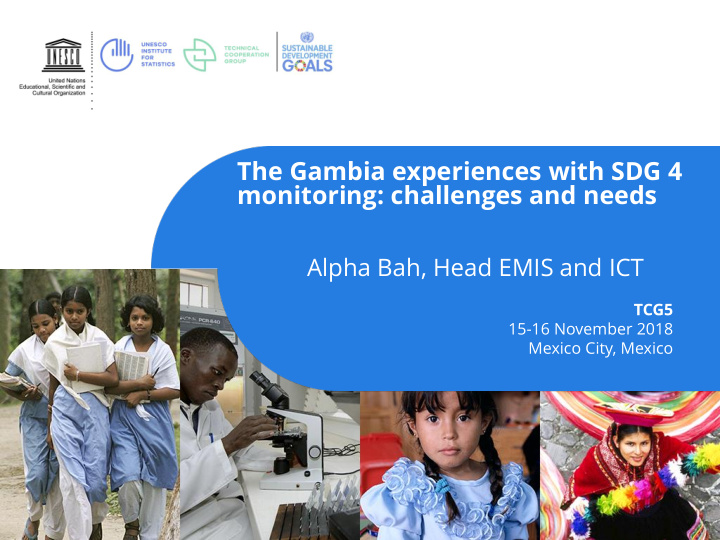



The Gambia experiences with SDG 4 monitoring: challenges and needs Alpha Bah, Head EMIS and ICT TCG5 15-16 November 2018 Mexico City, Mexico
The Enabling Environment The current education A National Development sector policy 2016-2030 National Strategy for the Plan 2018-2022 and its synchronized with the Development of Quarterly Progress SDG4. Accompanied Statistics 2017-2022 – Reporting (ppt) at the with ESSP and an M&E annual Sectoral ppt Office of President framework 2
Timeline of key Education policy documents in MoBSE (education sector), 2014-2018 Over the past decade, The Ministry has developed three comprehensive Education Policies covering the periods 2004-2015 and 2016-2030. Each policy was accompanied by an ESSP and an Education Sector Medium Term Plan (ESMTP) covering three to four years. CATEGORY 2013 2014 2015 2016 2017 2018 Sector policies National Education Policy 2004-2015 Education Policy 2016-2030 ESSP I 2006- ESSP III 2016- Sector plans ESSP II 2014-2022 2015 2030 ESMTP 2012- ESMTP 2018- Mid-term plans ESMTP 2014-2017 2015 2020 Education Coordination Conducted bi-monthly Committee meetings Joint Donor • • • • • • • • Reviews
Main Drivers A National EMIS Technical National EMIS Team is A joint Inter Ministerial Team (NETT) that currently developing the Senior Management Team constitutes members of one EMIS; This will shift to operationalized the both Ministries (Basic & the statistical observation policy Secondary and Higher & from the School to Tertiary ) Individual Learner the new EMIS tool will be tested during the 2018/19 academic year. – Unique ID for each Student and each EMIS Peer Review teacher – at the point of entry (admission) to cover Conducted by ADEA from Grade 1 to Higher and Tertiary institutions 4
Student / Learner Centered approach System Physical has School Facility has Books enrolls Is a manages takes Student Assessment Is in a Refers to Other Records and Routines Takes place Class Classroom Attendance Handles Refers to 5 Teacher
New EMIS Structure Central Regional Cluster School
Evidence based policy formulation • Education Sector Analysis in 2010 underscored the high cost of education by household. • Consequently, the Ministry introduced staggered free education – Primary 2013 – Lower Secondary 2014 – Upper Secondary 2015 • ESA and Public Expenditure Review 2017 – Oriented Focus on • Open Schooling • on certain regions • Early Childhood Education 7
What are the main challenges Data Integration • Data Integration and Sharing Among Ministries and other Agencies is critical but continuous to be a challenge; data from Ministries of Finance, Health, Population, Labour and Exam Councils need to be linked and integrated to conduct quality policy analysis and provide meaningful information. • These Ministries, departments have their own data systems to meet their needs. • For example the SDG4 (4.2.1) Proportion of children under 5 years of age who are developmentally on track in health, learning and psychosocial well-being, by sex . SDG4 (4.3.1) Participation rate of youth and adults in formal and non-formal education and training in the previous 12 months , by sex • This requires EMIS to go beyond its traditional settings 8
What are the main challenges Institutional Capacity The data demand and utilisation is also shifting from its traditional users; Education • Planners at the Head Office to the front liners; the classroom. Which advocate for a decentralised EMIS at the Regional, Cluster and School levels. Yet there is no commensurate institutional capacity across the data value chain. For example; The utilisation of School Improvement Grant (SIG) should be evidence-based. • (use learning outcomes to inform school development plans). For Regional and Head Office to approve your SIG Report school attendance data more often from termly to daily. • The school records management continuous to remain the same • Lack of comprehensive policy to guide users to response to this unprecedented • demand for more information, more often and with less resources. Current policies and strategies are limited and the stakeholder group • awareness is low. UIS Questionnaire A,B,C have been forthcoming but is likely to faced further • challenge considering the above challenges 9
ChallengesContinuous Measuring • The Education Sector Policy main Learning and theme and priorities Quality, Equity and Service Inclusion in Education; Having good Deliverable lessons learned for Access to Indicators Education • The challenge is how to measure progress and learning; who is learning and what are the best model for learning that can be used from school to another? • The Classroom Observation Tool (CoT) has been used and now we are looking at what are the education Service Deliverable indicators (SDI)? 10
Thanks to the continued Collaboration with Partners • All Ministries Departments and Agencies Partners and their Support Gambia Bureau of Statistics • is critical West Africa Exam Council • Civil society • Local Education Group includes Local UN Agencies • • International Development Partners The World Bank and GPE • UNESCO Institute of Statistics • UNESCO Pole Dakar • UNICEF • Statistical capacity including data collection instruments, ISCED mapping etc – thanks to collaboration with UIS GPE Data Round Table; Field Visit Team expected in Feb 2019. 11
Gracias! Thank you!
Recommend
More recommend